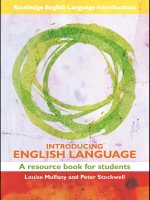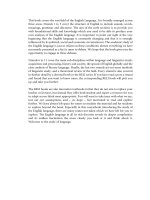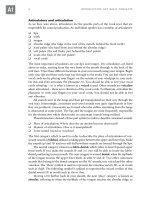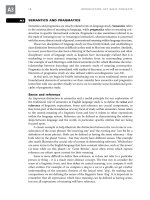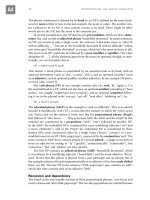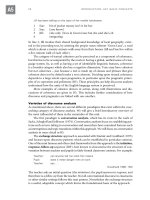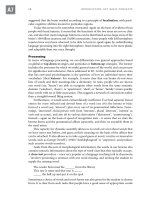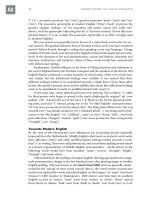Introdungcing English language part 1 docx
Bạn đang xem bản rút gọn của tài liệu. Xem và tải ngay bản đầy đủ của tài liệu tại đây (1.65 MB, 6 trang )
INTRODUCING ENGLISH LANGUAGE
‘In this exciting new textbook, Louise Mullany and Peter Stockwell have provided a
fresh and imaginative set of alternatives for teaching and learning a huge amount
about the English language. The book allows for creative and lateral approaches to
developing an understanding of important linguistic concepts and, together with the
thought-provoking activities, and accessible readings, guarantees there is something
to stimulate every learner.’
Janet Holmes, Victoria University of Wellington, New Zealand
‘Introducing English Language is ambitious in its scope, providing a comprehensive,
systematic introduction to a wide range of linguistic concepts as well as offering a
panoramic perspective on the full range of issues that come into view when these
concepts are used to ask questions about the English language.’
Chris Christie, University of Loughborough, UK
Routledge English Language Introductions cover core areas of language study and are
one-stop resources for students.
Assuming no prior knowledge, books in the series offer an accessible overview of
the subject, with activities, study questions, sample analyses, commentaries and key
readings – all in the same volume. The innovative and flexible ‘two-dimensional’
structure is built around four sections – introduction, development, exploration and
extension – which offer self-contained stages for study. Each topic can also be read
across these sections, enabling the reader to build gradually on the knowledge gained.
Introducing English Language:
q is the foundational book in the Routledge English Language Introductions series
and offers a grounding to all the titles featured in the series
q gives comprehensive coverage of the main aspects of the English language, as well
as providing an introduction to key disciplines of linguistics such as historical,
social and psycholinguistics, and also core areas in language study including acqui-
sition, standardisation and the globalisation of English
q uses a wide variety of real texts and images that include: a transcript of a conversa-
tion between George W. Bush and Tony Blair, a controversial ‘apology’ broadcast on
BBC Radio 4, excerpt from novels including ‘Alien’ and photographs from Hong Kong
q provides classic readings by the key names in the discipline including Guy Cook,
Joan Cutting, Zoltán Dörnyei, Andy Kirkpatrick and John Sinclair
q is accompanied by a supporting series website with additional activities, project
ideas for each unit, further guidance on areas mentioned in the book, a background
to the readings chosen, and weblinks to essential English Language resources.
Written by two experienced teachers and authors, this accessible textbook is an essen-
tial resource for all students of English language and linguistics.
Louise Mullany is Associate Professor in Sociolinguistics at the University of
Nottingham, UK
Peter Stockwell is Professor of Literary Linguistics at the University of Nottingham,
UK. He is the editor of the Routledge English Language Introductions series.
ROUTLEDGE ENGLISH LANGUAGE INTRODUCTIONS
SERIES EDITOR: PETER STOCKWELL
Peter Stockwell is Professor in the School of English Studies at the University of
Nottingham, UK, where his interests include sociolinguistics, stylistics and cognitive
poetics. His recent publications include Texture, 2009, Language in Theory, Routledge
2005 (with Mark Robson), Cognitive Poetics: An Introduction, Routledge 2002, The
Poetics of Science Fiction, Investigating English Language (with Howard Jackson), and
Contextualized Stylistics (edited with Tony Bex and Michael Burke).
SERIES CONSULTANT: RONALD CARTER
Ronald Carter is Professor of Modern English Language in the School of English Studies
at the University of Nottingham, UK. He is the co-series editor of Routledge Applied
Linguistics, series editor of Interface, and was co-founder of the Routledge Intertext series.
OTHER TITLES IN THE SERIES:
Language and Power
Paul Simpson & Andrea Mayr
Language and Media
Alan Durant & Marina Lambrou
World Englishes 2nd Edition
Jennifer Jenkins
History of English
Daniel McIntyre
Practical Phonetics and Phonology 2nd edition
Beverley Collins & Inger Mees
Pragmatics and Discourse 2nd Edition
Joan Cutting
Sociolinguistics 2nd Edition
Peter Stockwell
Child Language
Jean Stilwell Peccei
Language in Theory
Mark Robson & Peter Stockwell
Stylistics
Paul Simpson
Psycholinguistics
John Field
Grammar and Vocabulary
Howard Jackson
INTRODUCING
ENGLISH LANGUAGE
A resource book for students
LOUISE MULLANY
AND
PETER STOCKWELL
First published 2010
by Routledge
2 Park Square, Milton Park, Abingdon, Oxon OX14 4RN
Simultaneously published in the USA and Canada
by Routledge
270 Madison Avenue, New York, NY 10016
Routledge is an imprint of the Taylor & Francis Group, an informa business
© 2010 Louise Mullany and Peter Stockwell
All rights reserved. No part of this book may be reprinted or reproduced or utilised in any
form or by any electronic, mechanical, or other means, now known or hereafter invented,
including photocopying and recording, or in any information storage or retrieval system,
without permission in writing from the publishers.
British Library Cataloguing in Publication Data
A catalogue record for this book is available from the British Library
Library of Congress Cataloging in Publication Data
Mullany, Louise. Stockwell, Peter.
Introducing English Language : a resource book for students / Louise Mullany and
Peter Stockwell.
p. cm. — (Routledge English language introductions)
1. English language—Grammar. 2. English language. I. Stockwell, Peter. II. Title.
PE1112.M78 2010
428.0071—dc22
2009033498
ISBN 10: 0-415-44886-7 (hbk)
ISBN 10: 0-415-44885-9 (pbk)
ISBN 10: 0-203-85811-5 (ebk)
ISBN 13: 978-0-415-44886-4 (hbk)
ISBN 13: 978-0-415-44885-7 (pbk)
ISBN 13: 978-0-203-85811-0 (ebk)
This edition published in the Taylor & Francis e-Library, 2010.
To purchase your own copy of this or any of Taylor & Francis or Routledge’s
collection of thousands of eBooks please go to www.eBookstore.tandf.co.uk.
ISBN 0-203-85811-5 Master e-book ISBN
HOW TO USE THIS BOOK
The Routledge English Language Introductions are ‘flexi-texts’ that you can use to
suit your own style of study. The books are divided into four sections:
A Introduction – sets out the key concepts for the area of study. The units of this
section take you step-by-step through the foundational terms and ideas, carefully
providing you with an initial toolkit for your own study. By the end of the
section, you will have a good overview of the whole field.
B Development – adds to your knowledge and builds on the key ideas already intro-
duced. Units in this section may also draw together several areas of interest. By
the end of this section, you will already have a good and fairly detailed grasp of
the field, and will be ready to undertake your own exploration and thinking.
C Exploration – provides examples of language data and guides you through your
own investigation of the field. The units in this section will be more open-ended
and exploratory, and you will be encouraged to try out your ideas and think for
yourself, using your newly acquired knowledge.
D Extension – offers you the chance to compare your expertise with key readings
in the area. These are taken from the work of important writers, and are provided
with guidance and questions for your further thought.
You can read this book like a traditional text-book, ‘vertically’ straight through from
beginning to end. So you would establish a broad sense of the key ideas by reading
through section A, and deepen your knowledge by reading section B. Section C would
then present you with a programme of Activities to test out different aspects of your
broad knowledge. Finally, having gained a good level of competence, you can read
the section D articles and follow up the Further Reading.
However, the Routledge English Language Introductions have been carefully
designed so that you can read them in another dimension, ‘horizontally’ across the
numbered units. For example, units A1, B1, C1 and D1 constitute a strand introducing
you to phonetics, then developing your knowledge, then testing out and exploring
some key ideas, and finally offering you a key case-study to read. The strand across
A2, B2, C2, D2, and the other strands 3, 4, 5, and so on, all work in the same way.
Reading across the strands will take you rapidly from the key concepts of a specific
area, to a level of expertise in that precise area, all with a very close focus. You can
match your way of reading with the best way that you work.
The glossarial index at the end, together with the suggestions for Further Reading for
each strand will help to keep you orientated. Each textbook has a supporting website with
extra commentary, suggestions, additional material and support for teachers and students.
